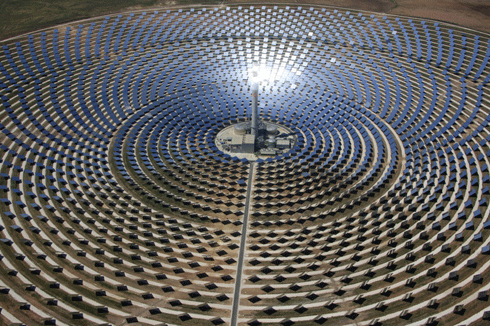
|
Published: 6 May 2013
No pipe dream: 100 per cent renewable energy could power Australia
The authors of Australia’s first significant study into providing 100 per cent renewable energy have welcomed a new report from the Australian Energy Market Operator (AEMO), which has found that it is technically feasible and affordable to run the National Electricity Market with 100 per cent renewable energy.

|
|
The Gemasolar solar power plant in Spain is the world’s first commercial solar plant with central tower receiver and molten salt heat storage technology. It can supply 110 GWh per year — enough to supply power to 27,500 homes. The plant has been operational since May 2011. Credit:
Torresol Energy/Wikimedia Commons under Free Art Licence
|
‘This validates the ground-breaking Zero Carbon Australia plan we launched in 2010, which outlined a way to get to 100 per cent renewable energy in ten years,’ said Patrick Hearps, Research Fellow with the Melbourne Energy Institute, University of Melbourne.
The Zero Carbon Australia Stationary Energy Plan, released in 2010 by climate solutions think-tank Beyond Zero Emissions and the Melbourne Energy Institute, showed how Australia could run on 100 per cent renewable energy in a decade.
As in the Stationary Energy Plan, AEMO’s analysis identified that concentrating solar thermal power with molten salt storage is a key enabling technology, as its thermal energy storage provides reliable power around the clock.
‘The key difference is in timescales. They model their 100 per cent renewable grid for 2030 and 2050, whereas we are looking at doing it in ten years, based on a responsible reaction time to the threat of climate change,’ Mr Hearps said.
AEMO is the body in charge of planning and operating the electricity networks for the entire eastern seaboard, covering about 90 per cent of Australia’s electricity consumption.
Its latest report has modelled supply and demand on an hourly timescale to make sure that renewable energy can meet the same reliability standards as the current electricity system is held to – no more than 0.002 per cent of energy demand unserved over a year.
AEMO’s analysis projected that wholesale electricity prices would rise to around 12.1-14 cents per kWh for the 100 per cent renewable scenarios. This is similar to the 12-12.5 cents per kWh expected for 2031 under business-as-usual, projected by consultants SKM MMA for the Government’s Renewable Energy Target review.
‘This is now the third recent report to show that 100 per cent renewable energy in Australia is possible’ said Mr Hearps. Researchers at the University of New South Wales have also shown the feasibility of 100% renewable energy under a range of scenarios.
‘We can have a reliable, affordable renewable energy future as soon as we want to build it,’ said Mr Hearps. ‘The only barrier now is the political will to start.’
Source: BZE



